Description
As described by Verne, Sword was a "submersible boat of only twelve tons", carrying a crew of four and commanded by a lieutenant. Her screw was worked by a couple of dynamos fitted with accumulators that needed to be charged in port, and which enabled her to cruise for only one or two days. She was divided into three watertight compartments. The aft one contained the accumulators and machinery. The middle, occupied by the pilot, was surmounted by a periscope fitted with lenticular portholes through which an electric search-lamp lighted the way through the water. The forward compartment was used for passengers.
In the 1890s, Sword was in the Port of St. George at the Bahamas when authorities found the pirate Ker Karraje had established himself in a cavern, accessible only by submarine, on the desolate neighboring island of Back Cup. Karraje had with him the French inventor, Thomas Roch, who agreed to give a powerful new explosive to the pirate. The news had arrived through a message placed in a keg by the engineer, Simon Hart, held captive in the pirate stronghold.
Sword, under Lt Devon, was sent to penetrate the stronghold and take Roch and Hart aboard. This Devon and his men did, but before they could get away they were discovered by the bigger pirate submarine and sunk. The British crew perished while Roch and Hart were recovered by pirate divers, to take part in the cataclysmic end of the story. Verne conceived submarine fighting as mainly ramming.
The book was written when Verne was well-disposed towards the British (his attitude fluctuated). Lt Devon is a noble and heroic officer, the equal of naval heroes in books by British writers.
The Royal Navy did, in 1943, give the name "Sword" to a surface ship being laid out at Newport News, Virginia, to be delivered to Britain as part of lend-lease. However, before it was completed the deal was off and the ship was delivered to the United States Navy, commissioned in 1944 as USS Rushmore. She had a long and distinguished career.

Twenty Thousand Leagues Under the Seas is a classic science fiction adventure novel by French writer Jules Verne.
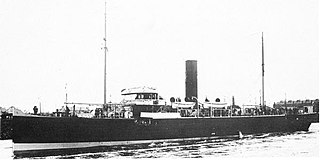
Q-ships, also known as Q-boats, decoy vessels, special service ships, or mystery ships, were heavily armed merchant ships with concealed weaponry, designed to lure submarines into making surface attacks. This gave Q-ships the chance to open fire and sink them. The use of Q-ships contributed to the abandonment of cruiser rules restricting attacks on unarmed merchant ships and to the shift to unrestricted submarine warfare in the 20th century.
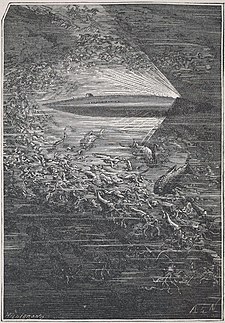
Nautilus is the fictional submarine belonging to Captain Nemo featured in Jules Verne's novels Twenty Thousand Leagues Under the Sea (1870) and The Mysterious Island (1874). Verne named the Nautilus after Robert Fulton's real-life submarine Nautilus (1800). For the design of the Nautilus Verne was inspired by the French Navy submarine Plongeur, a model of which he had seen at the 1867 Exposition Universelle, three years before writing his novel.

A brig is a type of sailing vessel defined by its rig: two masts which are both square-rigged. Brigs originated in the second half of the 18th century and were a common type of smaller merchant vessel or warship from then until the latter part of the 19th century. In commercial use, they were gradually replaced by fore-and-aft rigged vessels such as schooners, as owners sought to reduce crew costs by having rigs that could be handled by fewer men. In Royal Navy use, brigs were retained for training use when the battle fleets consisted almost entirely of iron-hulled steamships.

Jolly Roger is the traditional English name for the flags flown to identify a pirate ship about to or during an attack, during the early 18th century.

USS Nautilus (SSN-571) was the world's first operational nuclear-powered submarine and the first submarine to complete a submerged transit of the North Pole on 3 August 1958. Her initial commanding officer was Eugene "Dennis" Wilkinson, a widely respected naval officer who set the stage for many of the protocols of today's Nuclear Navy of the US, and who had a storied career during military service and afterwards.

The submarine film is a subgenre of war film in which the majority of the plot revolves around a submarine below the ocean's surface. Films of this subgenre typically focus on a small but determined crew of submariners battling against enemy submarines or submarine-hunter ships, or against other problems ranging from disputes amongst the crew, threats of mutiny, life-threatening mechanical breakdowns, or the daily difficulties of living on a submarine.

The X class was a World War II midget submarine class built for the Royal Navy during 1943–44. It was substantially larger than the original Chariot manned torpedo.
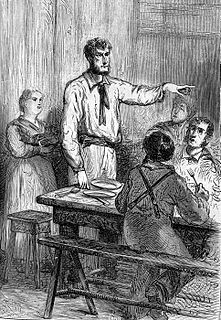
Tom Ayrton is a fictional character who appears in two novels by French author Jules Verne. He is first introduced as a major character in the novel In Search of the Castaways (1867–1868). He then reappears in a later novel, The Mysterious Island (1874), in which his fate, left unknown at the ending of the previous novel, is resolved, and during the course of which his character undergoes change and achieves a redemption.

Facing the Flag or For the Flag is an 1896 patriotic novel by Jules Verne. The book is part of the Voyages extraordinaires series.
A sword is a cutting and/or thrusting weapon.

Invention for Destruction is a 1958 Czechoslovak black-and-white science fiction adventure film, directed by Karel Zeman, produced by Zdeněk Novák, and starring Lubor Tokoš, Arnošt Navrátil, and Miloslav Holub. Based on several works by Jules Verne, primarily his 1896 novel Facing the Flag, the film evokes the original illustrations for Verne's works by combining live actors with various forms of animation.
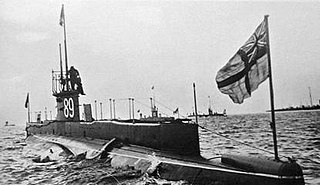
HMS E9 was a British E class submarine built by Vickers, Barrow. She was laid down on 1 June 1912 and was commissioned on 18 June 1914.

Farfadet (Q7) was an early submarine built for the French Navy at the beginning of the 20th century. She was of the Maugas type, and the name ship of her class. Farfadet accidentally sank in July 1905 at Bizerte with the loss of 14 men of her crew; two men survived. She was later refloated and recommissioned as the Follet (Q7). She was stricken in November 1913.
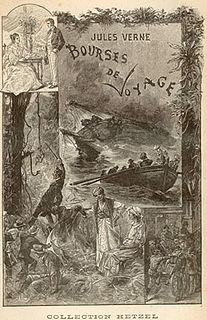
Travel Scholarships is a 1903 adventure novel by Jules Verne.
Captain Nemo: The Fantastic History of a Dark Genius is a novel by Kevin J. Anderson, published in 2002 by Pocket Books. It is a secret history and crossover work, the central premise being that many of the things Jules Verne wrote about existed in real life as told to him by the real Captain Nemo.
The Hrabri class consisted of two submarines built for the Kingdom of Serbs, Croats and Slovenes by the Vickers-Armstrong Naval Yard, on the River Tyne, in the United Kingdom. Launched in 1927, the boats were named Hrabri (Brave) and Nebojša (Fearless). Their design was based on that of the British L-class submarine of World War I, and they were built using parts originally assembled for L-class submarines that were never completed. The Hrabri-class were the first submarines to serve in the Royal Yugoslav Navy, and after extensive sea trials and testing they sailed from Newcastle upon Tyne to the Bay of Kotor on the southern Adriatic coast of Yugoslavia, arriving in April 1928. They were armed with six bow-mounted 533 mm (21 in) torpedo tubes, two 102 mm (4 in) deck guns, one QF 2-pounder L/39 anti-aircraft gun and two machine guns. Their maximum diving depth was restricted to 55 metres (180 ft) by Yugoslav naval regulations.

Result is a three-masted cargo schooner built in Carrickfergus in 1893. She was a working ship until 1967, and served for a short time in the Royal Navy as a Q-ship during World War I. She currently rests on land at the Ulster Folk and Transport Museum, and in 1996 was added to the National Register of Historic Vessels.
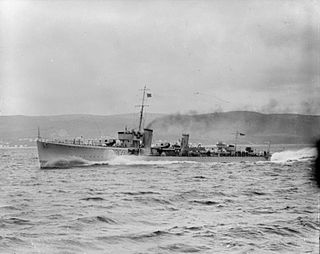
HMS Stronghold was an S-class destroyer, which served with the Royal Navy during the Second World War. The ship was one of the first vehicles to deploy an unmanned aircraft. Launched on 6 May 1919, the destroyer was fitted with a simple catapult in 1924, which used a bag of sand as a weight, and launched the RAE 1921 Target, an early form of unmanned aircraft. A more sophisticated cordite catapult was fitted in 1927 and used to launch the more advanced RAE Larynx. In total, more than twenty test flights were undertaken before the catapult was removed. The destroyer was subsequently fitted out as a minelayer. At the start of the Second World War, the destroyer was based in Singapore. Stronghold helped to rescue the Supermarine Walrus from the battlecruiser Repulse, which had been sunk by the Japanese, in 1941 and, the following year, towed the destroyer Vendetta on the first part of the Royal Australian Navy vessel's journey to Fremantle. On 2 March 1942, the vessel was spotted by a Japanese reconnaissance seaplane and attacked by the heavy cruiser Maya, along with the two escorting destroyers Arashi and Nowaki. Heavily outgunned, the destroyer was sunk with the loss of nine officers and sixty-one ratings.
















